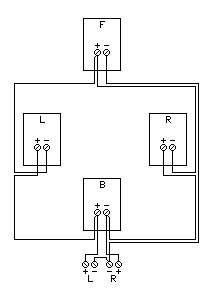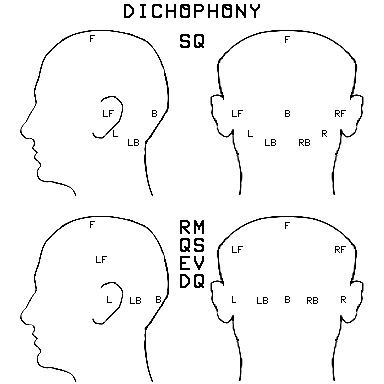SUBSTITUTING FOR QUADRAPHONICS
OR
"WHAT TO DO WHEN YOU DON'T HAVE THE DECODER
FOR THE QUADRAPHONIC RECORD YOU DO HAVE"
This situation is problematic because it has been 40 years since any quadraphonic equipment
has been manufactured. Much of this equipment has failed. So the question is how to play a
quadraphonic record you have.
First you have to decide how you want to play record and which type of record it is.
Choose the playback method to use:
- Play the record in stereo
Most quadraphonic records can be played on a stereo record player and heard in
stereo.
CD-4 and UD-4 records should not be played with a stereo cartridge unless the
record was already damaged by doing this.
Discrete quadraphonic tapes cannot be played on stereo equipment without a
special quadraphonic player. But matrixed tapes should play the same as matrixed records.
- Play the record or tape using quadraphonic equipment.
Continue to the next section.
Choose the type of recording you have:
 RM and QM (Sansui QS, Electro-Voice Stereo-4, & Dynaquad)
RM and QM (Sansui QS, Electro-Voice Stereo-4, & Dynaquad)
Ways to play RM and QM recordings:
- Use a modern surround receiver that plays Dolby Surround. It decodes these quite
well.
- Buy a used RM or QM decoder and use that with two stereo amplifiers.
- Use a stereo that has separate speakers, add some speakers, and use an RM or QM
speaker matrix:
- The original Hafler circuit (right)
- The original Dynaquad Quadaptor or equivalent circuit
- One of the various Dynaquad clone adaptors sold in the 1970s
- Build a UQ-HP, a UQ-1, or a
UQ-1A decoder
- Use the octophonic design found here
- Use stereo headphones to hear dichophony from
RM or SQ recordings
- Dolby Surround (Including VHS and DVD videos)
Ways to play Dolby Surround:
- Use a Dolby Surround receiver.
- Use a CircleSurround receiver.
- Use an RM or QM decoder with two stereo amplifiers.
- Use a stereo that has separate speakers, add some speakers, and use an RM or QM
speaker matrix:
- The original Hafler circuit
- The original Dynaquad Quadaptor or equivalent circuit
- One of the various Dynaquad clone adaptors sold in the 1970s
- Build a UQ-HP, a UQ-1, or a
UQ-1A decoder
- Use the octophonic design found here
- Use stereo headphones to hear dichophony from
RM or SQ recordings
- SQ
Ways to play SQ recordings:
- Use a modern surround receiver that plays Dolby Surround. But it confuses the back
channels.
- Buy a used SQ decoder and use that with two stereo amplifiers.
- Use a CircleSurround system and exchange the two back speakers.
- Use stereo headphones to hear dichophony from
RM or SQ recordings
- UMX, BMX, and UD-4
Ways to play UMX, BMX, and UD-4 recordings:
UD-4 records should not be played with a stereo cartridge unless the
record was already damaged by doing this.
UD-4 records can be played through a BMX decoder to get the matrix
playback.
- Use an SQ decoder and rearrange the speakers.
Put the LF and RF speakers to the L and R sides.
Put the LB speaker in the center front. Reverse its phase.
Put the RB speaker in the center back.
- Use a CircleSurround system and rearrange the speakers.
Put the LF and RF speakers to the L and R sides.
Put the RB speaker in the center front.
Put the LB speaker in the center back.
- Matrix H
Ways to play Matrix H recordings:
These are only approximations, but they are close. Separations are reduced:
- Use an SQ decoder and reconnect the speakers.
Connect both the LB and RB speakers to the RB output.
- Use a CircleSurround system and reconnect the speakers.
Connect both the LB and RB speakers to the LB output.
- Use an RM or QM decoder with two stereo amplifiers.
- Use a stereo that has separate speakers, add some speakers, and use an RM or QM
speaker matrix:
- The original Hafler circuit
- The original Dynaquad Quadaptor or equivalent circuit
- One of the various Dynaquad clone adaptors sold in the 1970s
- Build a UQ-HP, a UQ-1, or a
UQ-1A decoder
- Use the octophonic design found here
- Use a BMX decoder with two stereo amplifiers.
- UHJ Ambisonics
Ways to play Ambisonics:
These are only approximations, but they are close. Separations are reduced:
- Use an RM or QM decoder with two stereo amplifiers.
- Use a stereo that has separate speakers, add some speakers, and use an RM or QM
speaker matrix:
- The original Hafler circuit
- The original Dynaquad Quadaptor or equivalent circuit
- One of the various Dynaquad clone adaptors sold in the 1970s
- Build a UQ-HP, a UQ-1, or a
UQ-1A decoder
- Use the octophonic design found here
- Use stereo headphones to hear dichophony as from
RM recordings. Images will be displaced slightly here.
- Use an SQ decoder and reconnect the speakers.
Connect both the LB and RB speakers to the RB output.
- Use a CircleSurround system and reconnect the speakers.
Connect both the LB and RB speakers to the LB output.
- CD-4
Ways to play CD-4 records:
CD-4 records should not be played with a stereo cartridge unless the
record was already damaged by doing this.
Other than playing the record in stereo, there is no way to play a CD-4 record
without a CD-4 demodulator.
- Discrete quadraphonic tapes
Ways to play discrete quadraphonic tapes:
Other than using a player designed for this tape, there is no way to
play the tape and hear all of the music at once.
Quadraphonic Headphones Dichophony
 Ordinary stereo headphones can be used to decode SQ and RM recordings without the usual
decoder:
Ordinary stereo headphones can be used to decode SQ and RM recordings without the usual
decoder:
- Benjamin B. Bauer (CBS labs) discovered that ordinary stereo headphones can be used
to decode SQ matrixed recordings. ref
- This SQ decoding takes place in the human auditory system.
- The sound images are inside the head.
- Image locations are shown in the top set of diagrams at right.
- Bauer coined the term "dichophony" to describe the effect.
- While experimenting with SQ Dichophony, the page author discovered a similar pattern
that works for RM and QM recordings.
-This decoding also takes place in the human auditory system.
- It works for Sansui QS, Electro-Voice Stereo-4, and Dynaco recordings.
- The sound images are inside the head.
- Their locations are shown in the lower set of diagrams at right.
- The page author also discovered that dichophony also works for Dolby Surround and
Surrfield recordings.
- But in these cases, the sound images seem to be outside the head.
- Images are near the locations in the lower set of diagrams.
- With Surrfield, the images seem to be at the original distances of the
sounds.
Dichophony is sort of a universal decoder for SQ and RM/QM.
- It does not work correctly for UMX/BMX/UD-4 or Matrix H (below).
- It probably will work with Ambisonics UHJ.
- No special knowledge or repeated practice is needed to hear this.
The page author uses dichophony to monitor live RM mixes when he is
mixing a stage performance with no control room or no quadraphonic speakers.
It takes some practice to hear it correctly, but he usually gets the mix
he wants.
Dichophony can also be used with stereo speakers or in a movie theater
with stereo speakers but no Dolby Surround:
With stereo speakers, spread the speakers so they are about
160° apart.
- Face forward and the dichophony image will appear outside the
head.
In a movie theater with stereo, but no Dolby Surround, sit
in the center in the front three rows.
- Face forward and the dichophony image will appear outside the
head.
In either case, turning your head destroys the effect.
All of the above tricks can be used when the correct equipment is unavailable.
Links:
 RM and QM (Sansui QS, Electro-Voice Stereo-4, & Dynaquad)
RM and QM (Sansui QS, Electro-Voice Stereo-4, & Dynaquad)
 Ordinary stereo headphones can be used to decode SQ and RM recordings without the usual
decoder:
Ordinary stereo headphones can be used to decode SQ and RM recordings without the usual
decoder: